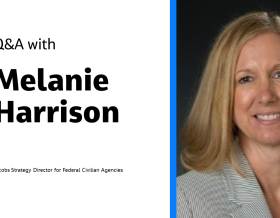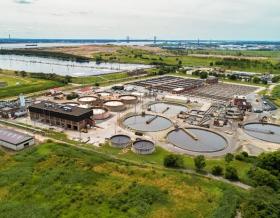




At Jacobs, we're challenging today to reinvent tomorrow by solving the world's most critical problems for thriving cities, resilient environments, mission-critical outcomes, operational advancement, scientific discovery and cutting-edge manufacturing, turning abstract ideas into realities that transform the world for good. With approximately $16 billion in annual revenue and a talent force of more than 60,000, Jacobs provides a full spectrum of professional services including consulting, technical, scientific and project delivery for the government and private sector.



As a purpose-led company, we know we have a pivotal role to play in addressing the climate emergency. We consider this not only good business, but our duty to channel our technology-enabled expertise and capabilities toward benefitting people and the planet.



For more than 70 years, our teams have provided integrated solutions to help solve the most complex and hazardous challenges of space exploration. We invent by imagining what’s possible.



Sit down with our visionary team of thinkers, dreamers and doers to see what a day in the life is like.



For more than 30 years, Jacobs has been responsible for planning and implementing Lead and Copper Rule-related strategies which protect millions of people in the U.S. and Canada. Our work includes enhanced water quality monitoring strategies, sampling plan development, harvested pipe-scale analysis, lead service line inventories and replacement plans, corrosion control studies and the incorporation of equity and environmental justice considerations into compliance programs.



Jacobs. A world where you can.



As our clients navigate the digital transformation and growing cyber risks, we have positioned ourselves at the forefront of this growth, adding digital capabilities, products and tools to serve a growing set of customers.



Jacobs is working to help clients across the United States secure federal funding for projects that make our cities and communities more connected and sustainable. Working hand-in-hand with clients from coast to coast and everywhere in between, Jacobs develops bold, innovative solutions to address the nation’s toughest challenges.



A curated selection of some of the top-listened to and trending podcast episodes from our popular If/When podcast series, which has over 4M downloads to date.



Now more than ever, we appreciate the hard work, sacrifice and dedication of the medical profession in ensuring the health and safety of our communities.



Together, we are stronger. Together, we can transform the future.



Together with our visionary partner, PA Consulting, we're establishing our position in high end advisory services, creating a springboard to expand in high value offerings beyond the core.



We work in partnership, delivering some of the most challenging, diverse and innovative projects and programs globally across multiple sectors. We integrate complex interfaces across planning, procurement and delivery to help unlock better social, environmental and economic outcomes from mega and giga projects.



We’ve provided design-build services to the water sector for over 25 years and delivered more than 150 projects. We offer fully integrated design-build and design-build-operate capabilities to tackle the most complex water challenges and work in close collaboration with our clients.



As climate change threatens water security around the world, more communities are turning to water reuse as a resilient water supply solution and embracing the OneWater principle that all water has value. Jacobs has been supporting clients with water reuse programs for decades, beginning with the first applications of advanced wastewater treatment technologies in the 1960s. We provide our clients with a full range of services, from water reuse feasibility studies to design, construction and operations.



Jacobs’ deep experience with advanced technology systems and our wide-ranging program support capabilities make us a premier partner at locations across the world. We deliver the right talent, tools and processes to support and enable our customers’ missions.



The National Air and Space Museum's One World Connected exhibit will tell the story of how flight fostered two momentous changes in everyday life: the ease in making connections across vast distances and a new perspective of Earth as humanity’s home. Below are some stories from Jacobs that also highlight the connections and digital solutions we are making around the world.



Stories that capture our partnerships and innovative impact for a more connected, sustainable world



The only certainty about the future is uncertainty. Resilience is an attribute of a smarter planet, and requires planning and adapting ahead of potential threats. We help our clients survive, recover, adapt and thrive.



Jacobs Global Technology Director - Coastal Planning & Engineering Professor Nigel Pontee recently led the production of a report for the UK Environment Agency which will inform future assessment of coastal squeeze and the requirement for the creation of compensatory habitat.
The work involved several colleagues within Jacobs as well as key contributions from Kenneth Pye Associates Ltd., and was;commissioned by the;Joint Flood and Coastal Erosion Risk Management Research and Development programme, part of;Environment Agency,;Department for Environment, Food & Rural Affairs,;Welsh Government;Natural Resources Wales.;This project arose from numerous studies for the Environment Agency over the past decade in addition to a series of technical papers that challenged;a widely accepted paradigm and identified areas where further work was required.
In the U.K., large areas of coastal habitats have been lost due to progressive phases of land claim over the past 2,000 years. Although losses due to large scale land claim have been much lower over the past 40 years, significant concerns remain about the indirect losses of coastal habitats caused by the presence of coastal defenses and rising sea levels. The term coastal squeeze is commonly used to describe this process, and it is a key driver for creating compensatory habitats.
In the past the ways that coastal squeeze has been defined and assessed around the U.K. have varied. In some places all habitat losses have been assumed to be as a result of coastal squeeze, where in fact the losses may be due other causes.
Report findings
Developed over a 2-year period, first and foremost, the report provided a more precise definition of the term ‘coastal squeeze’ for use throughout the U.K.; “….the loss of natural habitats or deterioration of their quality arising from anthropogenic structures or actions, preventing the landward transgression of those habitats that would otherwise naturally occur in response to sea level rise in conjunction with other coastal processes. Coastal squeeze affects habitat on the seaward side of existing structures.” The full report carefully explains each of the terms within the definition.
The revised definition differs from some previous definitions by including a number of additional elements: a wider range of habitats and structures, additional management activities, erosion caused by expansion of saltmarsh channels, and aspects of habitat quality.
The work also produced:
The work demonstrated that historic coastal squeeze losses may have been smaller than previous assessments have suggested since some of the losses may have been due to other causes. The report recommended that in the future, the assessment of coastal squeeze needs to more carefully consider the various possible causes for habitat loss. The report also noted that in the future, coastal squeeze could become more widespread due to accelerated sea-level rise.
Collaboration at its best
The report was developed in collaboration with numerous organizations across England and Wales including the Environment Agency, Natural England, and Natural Resources Wales. The project was steered by a group of 13 members from the Environment Agency, Defra, Natural England, Scottish Environment Protection Agency, Marine Management Organisation, Natural Resources Wales and Welsh Government.
Thanks to the professional and open discussion via many discussion meetings with the Project Board, the team successfully reached a consensus on various aspects of the work, especially the definition itself and the conclusions
““The concept of coastal squeeze is very well established within U.K. However, previous definitions and assessment methodologies have varied and have not always considered all of the causes for coastal habitat loss,” Jacobs Project Leader Professor Nigel Pontee shares. “Working with a small team of experts we were able to clearly explain the various causes for habitat loss, set out a precise definition and assessment method to improve future assessments. On this project the large number of organizations with different perspectives and knowledge provided an excellent learning opportunity for our team.”
Flood & Coast Excellence Awards Shortlist
Judges from the Flood & Coast Excellence Awards for 2021 shortlisted the report for an award.;These prestigious awards are a long-standing way to recognize the important work done in the previous year that has contributed to managing flood and coastal risk, building local flood resilience and taking action on climate change.
Chrissy Mitchell, project manager for the project at the Environment Agency adds, “This was a very important project for the Environment Agency. The impacts of this project are far reaching and go far beyond the Agency. It is relevant to all four U.K. nations and impacting upon the work of numerous organizations, plans and projects, including the Environment Agency, Defra, Welsh Government, Natural England, and National Resources Wales among others.”
Listen to our podcast
Want to read more about coastal squeeze? Check out the report and more below:
General Information and Summary Video:
Documents: